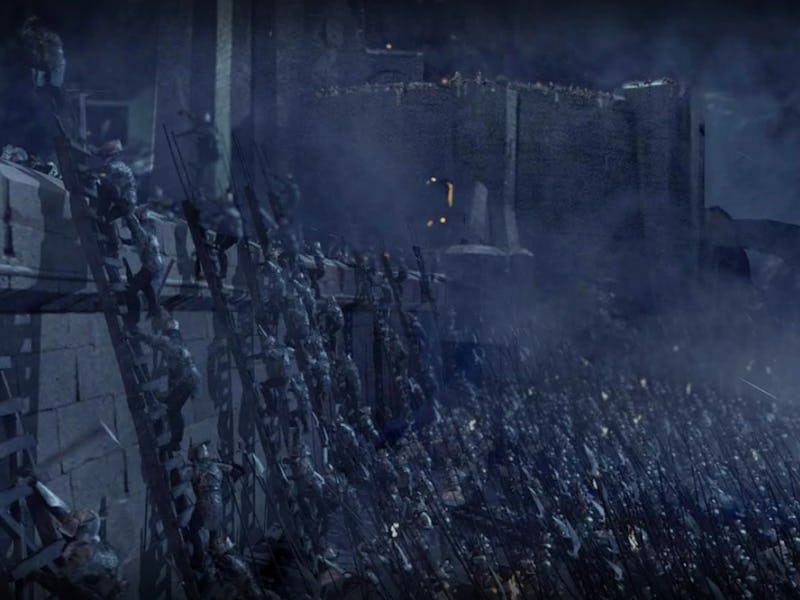How Peter Jackson made the greatest fantasy movie of all time
In 2002, Jackson delivered an epic unlike any other.

Following the massive success of Game of Thrones, there has been a renewed interest among Hollywood producers in creating expensive adaptations of beloved fantasy properties. Those pursuits have not only resulted in HBO producing its own Game of Thrones follow-up, House of the Dragon but in Netflix investing heavily in shows like The Witcher while Amazon spared no expense on The Wheel of Time and The Lord of the Rings: Rings of Power.
However, while all of these TV shows have created more than their fair share of memorable moments and awe-inspiring visuals, none of them have ever quite matched the sheer scope or technical craftsmanship of 2002’s The Lord of the Rings: The Two Towers. The second installment in director Peter Jackson’s Lord of the Rings trilogy is not only just as good as 2001’s The Fellowship of the Ring and 2003’s The Return of the King, but its climactic battle has also cast a shadow that not even Game of Thrones or the Harry Potter movies have ever truly been able to escape.
Unlike The Fellowship of the Ring and The Return of the King, which are defined by their statuses as the opening and closing chapters of their trilogy, The Two Towers doesn’t have to worry about setting up or resolving any of its multiple stories. The film gets to exist solely on its own terms, and the result is a fantasy blockbuster that provides all the escapist fun that a fan of the genre could want, as well as some of the most viscerally effective action storytelling that’s ever been captured on-screen.
The Two Towers has the most straightforward plotting of any of Jackson’s three Lord of the Rings films. Whereas both Fellowship of the Ring and Return of the King are comprised largely of detours and twists that constantly send their heroes careening in different directions, the characters in The Two Towers all move along a fairly straight path across the entirety of the film. From the moment it begins, the film is slowly marching toward its climactic battles at Helm’s Deep, Osgiliath, and Isengard. And so are the characters who inevitably end up at the center of those conflicts.
That structure gives The Two Towers the kind of constant, straightforward momentum that has similarly elevated action films like Mad Max: Fury Road. The script, which was penned by Fran Walsh, Philippa Boyens, Stephen Sinclair, and Peter Jackson, also fills it with minor conflicts and action sequences that never bring The Two Towers to a halt as much as they continually propel it forward. As a result, The Two Towers is not only one of the most constantly entertaining blockbusters you’ll ever see but also one of the most exhausting.
That’s not a slight against the film. The Two Towers uses its countless action sequences to wear down viewers until they’re just as tired as the film’s heroes. The fact that The Two Towers is able to do that without having to hit its viewers with endless instances of brutality is impressive in its own right. It’s even more impressive, however, given how the exhausting toll of the film ultimately elevates its climaxes, which revolve around last-minute rescues that are satisfying solely because of how well Jackson is able to place viewers in the same emotional space as The Two Towers’ protagonists.
Legolas (Orlando Bloom), Aragorn (Viggo Mortensen), and Gimli (John Rhys-Davies) meet Gandalf the White (Ian McKellen) in The Lord of the Rings: The Two Towers.
Beyond its numerous structural achievements, though, The Two Towers also boasts some of the most impressive battles and set pieces in blockbuster history. Not only are many of the film’s minor action sequences, including the Orc ambush that nearly does in Aragorn (Viggo Mortensen), thrilling and visually effective, but the film’s climactic conflict at Helm’s Deep remains, to this day, the most astonishing battle in fantasy movie history.
The sequence is paced perfectly. Jackson wisely punctuates the battle with small vignettes centered around Aragorn, Gimli (John Rhys-Davies), and Legolas (Orlando Bloom). Unlike some of the battle sequences featured in Game of Thrones, Helm’s Deep also avoids making the mistake of sacrificing its visual legibility for the sake of broody realism. The entire battle sequence is unrealistically well-lit, which allows the viewer to keep track of every beat of it. That approach also prevents some of the sequence’s more theatrical elements — like its never-ending rain — from getting in the way of the battle’s visual effectiveness.
Jackson’s emphasis on minimal CGI effects and practical stunt choreography further imbues the climactic set pieces of The Two Towers with a level of tangible realism that isn’t present in even the best action sequences in The Witcher or any of the Harry Potter movies.
Éowyn (Miranda Otto) stands at the top of Edoras in The Lord of the Rings: The Two Towers.
The same can be said for all of The Two Towers, which is the rare fantasy production that makes every one of its locations and action sequences feel as real as possible. Nowhere else in his Lord of the Rings trilogy is Peter Jackson’s ambition as a filmmaker more clear. Helm’s Deep remains one of the most endlessly thrilling action sequences that has ever been staged for the big screen, and that’s due in large part to Jackson’s clear, practical vision for The Two Towers.
20 years after the film was released, Jackson’s ambition can still be felt in every frame of The Two Towers, a film that not only attempts to do more than almost any other blockbuster ever has but also succeeds in doing so.
The Lord of the Rings: The Two Towers is streaming now on HBO Max.
This article was originally published on